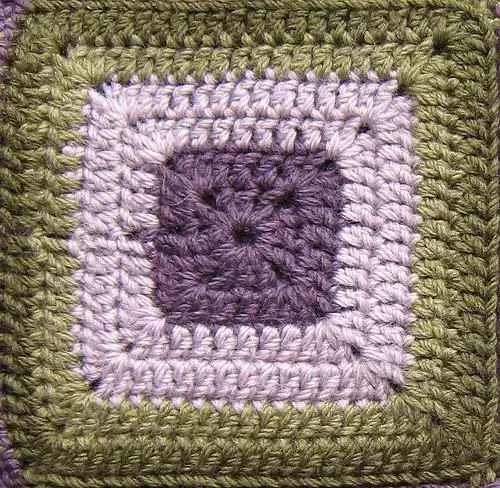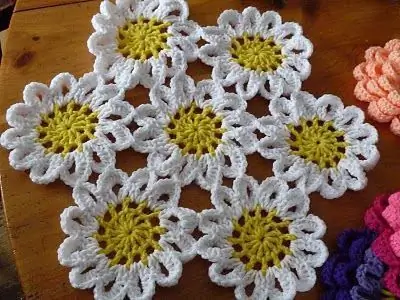
Inhaltsverzeichnis:
- Autor Sierra Becker [email protected].
- Public 2024-02-26 04:44.
- Zuletzt bearbeitet 2025-01-22 22:11.
Stricken Sie ein quadratisches Testmuster, wenn Sie ein neues Muster lernen. Häkelmotive können auch absichtlich gemacht werden, indem die am besten geeigneten Muster ausgewählt werden. Nachdem Sie einen zusätzlichen Betrag gesammelt haben, verbinden Sie sie zu einem Plaid.
Ein einfaches Quadrat für ein Plaid oder einen Schal
Seine Schönheit besteht darin, eine durchbrochene Bordüre auf eine klassische Basis zu binden. Nur müssen Sie solche Muster mit kleinen Motiven (gehäkelt) und Quadraten verbinden. Ihre Schemata sind so einfach wie möglich.
In einem Ring aus fünf Schleifen 8 Verbindungspfosten binden. Acht Luft, zwei Stäbchen. Wiederholen Sie dann dreimal 5 Luft- und zwei Stäbchen. Beende die Reihe mit einer weiteren Sp alte und schließe sie in der dritten Luft der ersten acht.
Die nächste Reihe beginnt mit 3 M und 2 Stäbchen. Ihnen folgen 5 Luft. Die Reihe wird mit sechs Stäbchen fortgesetzt. Zwei Wiederholungen: 5 Luft und 6 Sp alten. Wieder fünf Luft und 3 Säulen mit einer Häkelarbeit, schließe den Kreis.
Letzte Reihe des Quadrats: Luft 3, 4 Stäbchen. Dann 5 Luftmaschen und schon 10 Stäbchen. Fahren Sie mit zwei Wiederholungen von 5 Luft und 10 Sp alten fort. Vervollständigen Sie die Reihe mit 5 Luft, 5 Sp alten undschließe es in der dritten Luft am Beginn der Reihe.
Jetzt beginnt das Schnüren. Die erste ist die "Folie": Verbindungssäule, 4 Luft, 3 Stäbchen, geschlossen mit einer Schleife, 4 Luft und Verbindung zur letzten Sp alte der vorherigen Reihe. Binden Sie nach 6 Verbindungssäulen im Bogen der Luftschleifen zwei weitere solcher "Folien" hintereinander. Wiederhole diese Bindung bis zum Ende der Reihe.
In der nächsten Reihe über der Rutsche müssen Sie Folgendes binden: 3 Luft, Verbindungssäule mit der Oberseite der Rutsche, 3 Luft, Verbindung mit der Basis der Rutsche. Die Ecken des Musters werden durch drei Bögen mit drei Luftschleifen und Verbindungspfosten zwischen ihnen gebildet.
Zum Ausfüllen des Musters (gehäkelt): Motive aus kleinen Quadraten. In einem Ring aus 5 Schleifen 8 Verbindungspfosten binden. Dies ist die erste Reihe. Die zweite (auch bekannt als letzte) wird durch Bögen aus 5 Luftschleifen gebildet, die mit einzelnen Häkeln vervollständigt werden.
Solche Motive werden in „Folien“verbunden und kleine Quadrate in die Lücken zwischen ihnen genäht.

Durchbrochenes rundes Muster
Ein Ring aus sechs Maschen ist die Grundlage für das Häkeln eines solchen Musters. Motive können dann unterschiedlich sein. Eine Option ist unten gezeigt.
Die erste Reihe sollte mit 15 Stäbchen gefüllt werden, abwechselnd mit einer Luftmasche. Sie benötigen 4 Hebeschlaufen. Binden Sie in der zweiten Reihe in jeder Luft und oben in der Sp alte eine feste Masche. Hier benötigen Sie 2 Luft zum Heben.
Die dritte Reihe besteht aus einer Sp alte mit einer Häkelarbeit in jeder dritten Schleife. Sie müssen mit drei abgewechselt werdenLuftschleifen. Der Anstieg in dieser Reihe ist gleich drei Luft.
Im vierten ist jeder Bogen die Basis für vier Säulen mit zwei Häkeln, die mit einer Schleife abgeschlossen sind. Zwischen ihnen ist der Raum mit 4 Luft gefüllt. Anstieg - 3 Schleifen.
Rise - zwei Schleifen. Die fünfte Reihe wird mit festen Maschen gestrickt. Der erste Bogen wird mit dem 5. gefüllt, ab dem letzten Zifferblatt 11 Luftschleifen. Befestigen Sie es am ersten und binden Sie es mit 18 Säulen zusammen, sodass Sie zwei Schlaufen zum Anheben bilden. Der nächste Bogen wird mit nur fünf Säulen gestrickt. Wechseln Sie dieses Muster bis zum Ende der Reihe.
Die letzte (sechste) Reihe ist mit Stäbchen gefüllt, dazwischen werden zwei Luftmaschen gestrickt. Außerdem müssen die Säulen nur an acht Blütenblättern gestrickt werden. Darüber hinaus muss an jeder zweiten Stelle oben ein Bogen aus 10 Luftbögen mit 18 Einzelhäkeln gebunden werden.

Noch ein Quadrat
Sein Muster ist das gebräuchlichste von denen, die zum Häkeln eines Motivplaids empfohlen werden. Das Muster kann leicht variieren, aber die Basis ist die gleiche: abwechselnd Stäbchen und Luftmaschen.
Stricken Sie auf einem Ring mit 5 Maschen die erste Reihe des Motivs: 8 Verbindungssäulen. Der zweite beginnt an der Ecke. Es besteht aus 6 Luftschlaufen, einer Doppelhäkelarbeit an der Basis der getippten Kette. Binden Sie in der zweiten Sp alte der vorherigen Reihe zwei Sp alten mit einer Häkelarbeit und dazwischen eine Luft. Die dritte Säule bildet die Grundlage der zweiten Ecke, die aus zwei Säulen und drei Luftschleifen zwischen ihnen gestrickt ist. Wiederholen Sie in jeder Geraden das für die zweite beschriebene Muster und inungerade - für den dritten. Dies bildet die Ecke.
Dritte Reihe. Beginn - drei Hebeschlaufen von der Mitte der ersten Kurve. Im selben Bogen: zwei Stäbchen. Luftschleife. Dann kommt das sich wiederholende Muster. Binden Sie im Bogen der Seite, die von einer Luftschleife gebildet wird, drei Säulen mit einer Häkelarbeit. Luftschleife. Im Eckbogen: drei Stäbchen, drei Luft, drei Stäbchen. Luftschleife.
Die vierte Reihe ist ähnlich wie die dritte, nur müssen die Stäbchen jeweils 4 gemacht werden und keine Luft dazwischen, außer an den Ecken. Ganz in der Mitte der Eckelemente sollten noch 3 Luftstücke sein.
Die letzte Reihe eines solchen Häkelmusters (Motive werden fortgesetzt) besteht aus Verbindungsstäben. Machen Sie in jeder Verbindung von Säulengruppen und der Oberseite der Ecken ein Picot. Das heißt, stricken Sie drei Luftschleifen und schließen Sie sie an die ursprüngliche. Verbindungsmotive für diese Pico.

Dreiecksmuster
Sie werden wie quadratische Motive gehäkelt. Mit den Schemata müssen Sie nur ein wenig arbeiten. Machen Sie nämlich die Seiten etwas länger und erh alten Sie nur drei Ecken.
Übrigens sollte die Füllung der Eckmuster etwas dichter sein, damit das Muster ordentlicher aussieht. Pico muss nur in den Ecken des Motivs gestrickt werden. Weil die Seiten gut nebeneinander liegen und ohne sie. Obwohl sie aus Gründen der Luftigkeit immer noch aufgeführt werden können.

3D Blumenmuster
Ein ausgezeichnetes Geschenk für ein Mädchen - ein Plaid aus Quadraten, dessen Grundlagesind solche Blumenmotive (gehäkelt). Ihre Schemata sind einfach, aber die Wirkung ist erstaunlich.

Beginnen Sie erneut im Ring der 6 Schleifen. In der ersten Reihe müssen Sie 8 Gruppen bilden, die aus fünf Stäbchen bestehen. Außerdem müssen sie aus einer Basis gestrickt und mit einer Schlaufe geschlossen werden. Dazwischen je eine Luftschleife binden.
Die zweite Reihe sind die gleichen Gruppen, nur müssen sie doppelt so oft gestrickt werden. An die Spitze des vorherigen und in die Luft. Es werden also doppelt so viele sein.
Die dritte Reihe wird benötigt, um das Motiv in einem Quadrat zu verzieren. Stricken Sie zuerst die erste Ecke: drei Schlaufen, zwei Säulen mit zwei Häkeln, zwei Schlaufen, drei Säulen mit zwei Häkeln - alles zu einer luftigen Blume. In den nächsten beiden Sp alten mit einer Häkelarbeit. Dann zwei ohne Häkeln. Auf die gleiche Weise weiterstricken und nach und nach die restlichen drei Ecken formen.
Mit festen Maschen ein quadratisches Motiv binden. Machen Sie zwei Luftschleifen in den Ecken.

Motive miteinander verbinden
Am einfachsten ist es, sie zusammenzunähen. Aber das ist für Anfängerinnen. Für diejenigen, die bereits Motive und fertige Produkte daraus stricken, ist die Häkeloption praktisch. So sieht ein Plaid aus Häkelmotiven (das Diagramm ist im Artikel dargestellt) ordentlich aus.
Es ist notwendig, darin Stäbchen zu machen, die in einem Element und dann in einem anderen gestrickt werden. Erfahrene Handwerkerinnen raten, zuerst mehrere lange Streifen zu stricken. Verbinden Sie sie dann miteinander.
Empfohlen:
Häkeln lernen von zwei schönen Fischgrätenmustern. Interessante Motive im Sparschwein der Ideen

Der Haken ist ein wunderbares Werkzeug, mit dem Sie Muster von unglaublicher Schönheit erstellen können. Wenn Sie lernen möchten, wie man nicht triviale, interessante Motive mit Ihren eigenen Händen strickt, ist dieser Artikel für Sie hilfreich. Darin sehen wir uns an, wie man zwei originelle Fischgrätenmuster häkelt. Die im Artikel vorgestellten Diagramme und Beschreibungen des Arbeitsprozesses sind auch für Anfänger in der Arbeit mit einem Haken verständlich
Einfache Häkelanleitungen für Tücher aus der Ecke

Vielleicht hat jede Strickerin einen wunderschönen durchbrochenen Schal in ihrem Arsenal. Das ist nicht nur ein Kleidungsstück, das bei Kälte wärmt und für Gemütlichkeit sorgt, sondern oft auch ein schönes und modisches Accessoire, das Abwechslung in die Garderobe bringt
Gänseblümchenmuster häkeln. Häkelanleitungen: Diagramme und Beschreibung

Häkelmuster für Gänseblümchen sind sehr vielfältig. Gänseblümchen schmücken alle Kleidungsstücke (Schal, Oberteil, Kleid, Gürtel), Tasche, Interieur. Erwägen Sie Meisterkurse zum Stricken von flachen Gänseblümchen, Broschen und Blumen
Decken Sie sich mit Ihren eigenen Händen auf dem Sofa ab. Tagesdecken auf dem Sofa: Foto, Muster

Das Nähen einer Tagesdecke auf einem Sofa mit eigenen Händen ist nicht so schwierig, wie es auf den ersten Blick erscheinen mag. Das Wichtigste ist, die richtigen Maße zu nehmen und den richtigen Stoff für die gesamte Innenausstattung auszuwählen
Gehäkelte "Zickzack"-Decken stricken

Es gibt eine große Auswahl an gehäkelten Decken sowie Strickstile für diese wärmenden Tagesdecken. Selbst die einfachsten Muster sehen auf Teppichen interessant aus und werden immer mit dem Haus des Stiefvaters, Wärme und Fürsorge in Verbindung gebracht. Und wir werden versuchen, ein Zickzackmuster zu stricken
